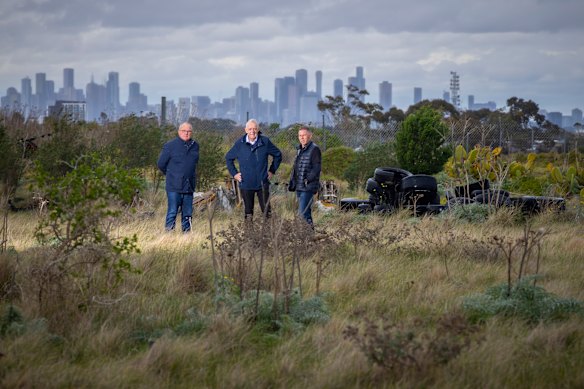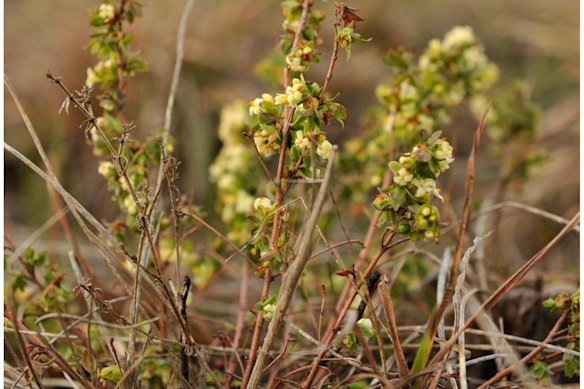By Adam Carey
Solomon Heights should be prime real estate.
Ten kilometres from the city, close to the Western Ring Road and the planned Melbourne Airport Rail, the 33-hectare precinct in Sunshine North has Maribyrnong River frontage, city skyline views and abundant open space.

Bruce Lancashire (centre), says Solomon Heights in Sunshine North is “Melbourne’s worst urban blight disaster”.Credit: Wayne Taylor
Real estate listings spruik properties within the precinct for their “excellent long-term prospects”.
But buyer beware.
The precinct also lacks basic services such as power, gas, water, roads and footpaths. Ninety-nine years after it was subdivided for housing, not a single building permit has been issued here.
Its grassy expanses were rezoned to industrial long ago but have become a magnet for rubbish dumpers and an unchecked breeding ground for noxious weeds.
“This is Melbourne’s worst urban-blight disaster in terms of a subdivision that hasn’t been allowed to be developed,” says Bruce Lancashire, a former Brimbank mayor who has turned civic campaigner in his retirement.
The precinct’s 440 lots have more than 140 owners, many of them local families who have clung to their investment for generations, paying council rates and land taxes for no return.
“If you bought a block of land somewhere in inner suburbia and then discovered you can’t develop it, I think you’d be fairly upset about that fact. That’s quite unreasonable,” says Lancashire, who does not own property in the precinct.
The intergenerational failure to develop Solomon Heights has been blamed on a tangle of planning problems, according to Brimbank City Council analysis: it’s hard to reach, with one road in and out of the precinct; its residential-sized lots are unsuitable for large-scale industry; and its neglected expanses are a refuge for several critically endangered plants and animals, including the striped legless lizard and the golden sun moth, which are protected under federal and state environmental laws.
But the century-long campaign to develop Solomon Heights has never stopped.
Glen Ora, a company that owns the undeveloped roads in the southern half of the precinct, has launched legal action to try to connect the area to water and kickstart development.
The company has gone to the Victorian Civil and Administrative Tribunal, appealing Greater Western Water’s refusal earlier this year to grant water connection permits in the precinct. A statement of contentions seen by The Age says the refusal “would stifle and prevent the future creation of infrastructure works in the subdivision”.
The company has also approached the Department of Transport and Planning about developing Solomon Heights for housing, but it has been told there are no plans to rezone the area from industrial to residential.
Glen Ora director Ron Silverstein was reluctant to comment to this masthead about his company’s legal bid to force Greater Western to plumb the estate before VCAT has made a decision.

Solomon Heights has become a magnet for illegal rubbish dumping.Credit: Wayne Taylor
“What I’m prepared to say is there’s an enormous amount of green tape involved in a transaction like this … from the Commonwealth, state and council,” he said. “There’s a huge regulatory system, which is complex, very expensive, and you need very deep pockets to do something like this.”
The company is fighting to develop the Solomon Heights as it awaits a separate judgment over whether it is liable for rubbish dumping on the land.
The Commonwealth-run Australian Rail Track Corporation, which owns land in Solomon Heights, has sued Glen Ora for more than $828,000, plus costs and interest. According to a statement of claim filed in court, subcontractors hired by Glen Ora dumped contaminated construction spoil, including asbestos, copper and lead, on ARTC-owned land.
Glen Ora has denied liability for the dumped spoil and a judgment is pending.
When The Age visited Solomon Heights last week, it was clear rubbish dumping was a persistent problem. There were piles of old tyres, a rusted car body, mounds of mangled wires and rotting timber. The flat, grassy terrain is also choked with artichoke thistle and prickly pear.
But Silverstein was eager to show this masthead something else that grows hidden among the weeds, and which is key to the precinct’s future.
“One of the features of this property is that it’s got a critically endangered plant and I don’t want you to laugh when you see it. It’s extremely valuable,” he said.
In an overgrown corner of the estate near the Melbourne-Sydney railway line, eight spiny rice-flower plants grow, although only a trained eye would spot them.
Each critically endangered plant is marked by a stake tied with a ribbon. The delicate yellow-flowered plants are protected under environment and biodiversity laws.

There are 240 critically endangered spiny rice-flowers growing in Solomon Heights.
There are 240 spiny rice-flowers in the estate, according to ecological surveys.
“People look at them and they can’t understand why they’re so important, and the answer is, I don’t know either,” Silverstein said.
Brimbank council has spent several years in a state of planning paralysis over Solomon Heights.
In a 2019 report, it named the existence of protected plants and animals as a key impediment to development, along with the difficulty of getting property owners in the precinct to agree on a way forward.
In 2022, it completed a feasibility study into creating a conservation reserve in the northern part of the estate. The Age sought a copy of the study via a freedom-of-information request but was denied, with the council saying the report is confidential.
“The document contains land use planning information, being information that, if prematurely released, is likely to encourage speculation in land values, which can be commercially sensitive,” Brimbank said.
Individual lots are currently listed for more than $230,000 each.
The council said it has no plans to pursue public acquisition of any part of the estate.
Lancashire argues that the southern part of the estate should be developed into an industrial estate that would boost local employment, and the northern section converted into an environmental reserve.
“There is a way forward,” he says. “To see that this has been going on in my community for 100 years is gut-wrenching … we’ve done environmental study after environmental study. We need to stop the delays, we need to come back with a report on how to actually do it.”
Monash University senior lecturer in urban planning Dr Elizabeth Taylor has studied Solomon Heights and other “zombie subdivisions” like it, which are “the living dead of the real estate market”, seemingly trapped in time and unable to be developed.
In her research, Taylor wrote that many potential solutions have been posed for the estate but “a default position of inaction has defined it for nearly a century”.
This is partly because current planning laws were not written with a 99-year-old riddle like Solomon Heights in mind. But mostly, it comes down to the cost of fixing the problem and the likely gap between what the council would be prepared to spend on compensation versus what the private landowners would demand.
“You can imagine Solomon Heights maybe being a cool park or something like that, but it just gets stuck because nobody wants to pay for it,” Taylor said.
Start the day with a summary of the day’s most important and interesting stories, analysis and insights. Sign up for our Morning Edition newsletter.